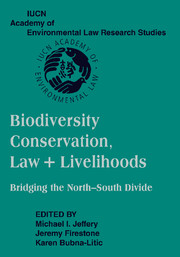 Biodiversity Conservation, Law and Livelihoods: Bridging the North-South Divide
Biodiversity Conservation, Law and Livelihoods: Bridging the North-South Divide Book contents
- Frontmatter
- Contents
- Acknowledgments
- Message from Kofi A. Annan, Secretary-General of the United Nations
- Macquarie Statement
- Contributors
- Introduction
- PART ONE THE CONTEXT
- PART TWO BIODIVERSITY: ITS CONSERVATION
- PART THREE CONSERVATION MEASURES
- PART FOUR USES OF COMPONENTS OF BIODIVERSITY
- PART FIVE PROCESSES AFFECTING BIODIVERSITY
- PART SIX BIOSECURITY ISSUES
- 25 Prevention and Control of Alien Invasive Species – China's Implementation of the CBD
- 26 Who Is to Blame? Liability and Redress Related to GMOs
- 27 The Reality and Effect of “Advance Informed Agreement” under the Cartagena Protocol
- PART SEVEN ACCESS AND BENEFIT-SHARING
- Index
26 - Who Is to Blame? Liability and Redress Related to GMOs
Published online by Cambridge University Press: 31 July 2009
- Frontmatter
- Contents
- Acknowledgments
- Message from Kofi A. Annan, Secretary-General of the United Nations
- Macquarie Statement
- Contributors
- Introduction
- PART ONE THE CONTEXT
- PART TWO BIODIVERSITY: ITS CONSERVATION
- PART THREE CONSERVATION MEASURES
- PART FOUR USES OF COMPONENTS OF BIODIVERSITY
- PART FIVE PROCESSES AFFECTING BIODIVERSITY
- PART SIX BIOSECURITY ISSUES
- 25 Prevention and Control of Alien Invasive Species – China's Implementation of the CBD
- 26 Who Is to Blame? Liability and Redress Related to GMOs
- 27 The Reality and Effect of “Advance Informed Agreement” under the Cartagena Protocol
- PART SEVEN ACCESS AND BENEFIT-SHARING
- Index
Summary
INTRODUCTION
Although scientists and farmers have for centuries engaged in plant manipulation and cross-breeding, it was not until the discovery of the DNA molecule in 1953 that a new mode of genetic manipulation was made possible. Agricultural biotechnology now utilizes recombinant DNA techniques to transfer genes between species and from one cell to another. As such, the resultant genetically modified organisms (GMOs) can draw from a more diverse gene pool and offer valuable phenotypes not available through conventional breeding. The so-called first generation GM crops, that is, those modified for resistance to insect pests, herbicides, and viruses, have mostly benefited producers of GMOs, whereas second-generation crops are in the process of development and they are more likely to benefit consumers.
The development of genetically modified foods has mushroomed since 1953. It is now estimated that the United States has 72 percent, Argentina 17 percent, and Canada 10 percent of its agricultural land planted with genetically modified crops. The technology of genetically modified organisms is still relatively new, however, and, as with any new technology, it carries some level of risk. Harm can occur in a number of circumstances from the cradle to the grave route of biotechnology and some risks such as safety and health hazards are as yet undetermined. Other risks have been clearly established. For example, approximately nine class action suits have been brought in the United States against the biotech company Aventis over the contamination of corn.
- Type
- Chapter
- Information
- Biodiversity Conservation, Law and Livelihoods: Bridging the North-South DivideIUCN Academy of Environmental Law Research Studies, pp. 485 - 499Publisher: Cambridge University PressPrint publication year: 2008
